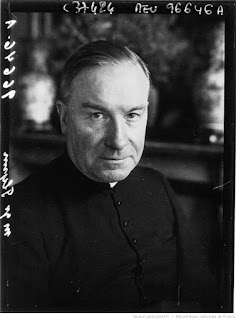The global greening of landmark buildings around the world to mark Ireland's national holiday is unprecedented. At this time, I thought it would be interesting to see how things were done in times gone past.
In March 1932, St. Patrick's Day was celebrated in Paris with more vigour than was previously the case. Apparently, this was because 1932 marked the 1,500th anniversary of St. Patrick's arrival in Ireland as a missionary from France.
Excelsior, 18 March 1932. Photograph after Mass in the Eglise de la Madeleine, Paris. Source:
Gallica BnF.
According to several French newspapers from the time, St. Patrick's Day in 1932 began with 10:30am Mass in the Church of the Madeleine in central Paris. It was presided over by the Archbishop of Paris and the Apostolic Nuncio. The Irish Minister to France, Count O'Kelly de Gallagh; Frederick Boland, Secretary of the Irish Legation in Paris, and representatives of the French government were in attendance. Also present were French families of Irish origin or descendants of the 'Wild Geese' as they are sometimes known.
Members of the Diplomatic Corps, the Director and students from the Irish College in Paris, together with Irish people resident in Paris (the Irish Colony) and their French friends, were also present. Many of the congregation were wearing a sprig of shamrock, as the Irish Minister had some shamrock sent over from Ireland for the occasion.
Le Figaro, 17 March 1932. Article explaining what will happen in Paris for St. Patrick's Day.
Several events took in the evening time to mark St. Patrick's Day. A ball was held at the Irish Legation. Apparently the Archbishop had to give a special dispensation for the ball to go ahead because it was taking place during the period of Lent. A talk on Ireland was given by Anatole Rivoallan, a specialist in Irish Studies at the Sorebonne, and it was transmitted by Radio-Paris.
According to the article below, a banquet was also to be held at the Palais D'Orsay Hotel, presided over by Lord Ashbourne (William Gibson), who was president of the Gaelic League. Leopold Kerney, a former Irish envoy to Paris, was to speak about the current Irish political scene. Irish music was to be played and the dancing would go on to 2 o'clock in the morning. There's no mention of turning the buildings green though! Happy St. Patrick's Day.
L'Intransigeant, 18 March 1932. Photograph showing Count O'Kelly at the ceremony. Source:
Gallica BnF.












































